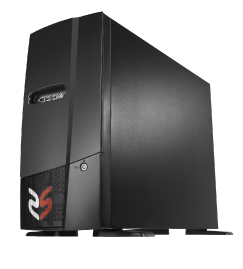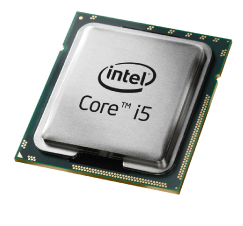With the levels of performance offered by today’s multi-core chips, the term ‘entry-level workstation’ is often a bit of a misnomer.
For CAD, virtually all modern workstations are powerful enough for standard 3D modelling tasks and it’s only when you start upping the ante with large assembly modelling, rendering, or simulation that specs need to be stepped up a notch. As tech progresses, yesterday’s ‘mid-range’ soon becomes today’s ‘entry-level’ and by embracing Intel’s new Core i5 processor at the heart of its new WS1400 workstation, this is effectively what Derby-based Workstation Specialists (WS) has done.

Until recently Workstation Specialists used Intel’s Core 2 Duo as its entry-level workstation processor, reserving the Core i7 for its mid-range machines. However, with the introduction of the Core i5 and new generation Core i7 processors, this has changed and WS is now able to boost the performance of its entry-level workstation range, without significantly increasing the price point.
The WS1400 is available with three processor options – the Core i5 750 (2.66GHz), Core i7 860 (2.80GHz) and Core i7 870 (2.93GHz). While the Core i5 750 inside our test machine enables WS to bring the price in just under the £1,000 mark, those that use rendering alongside their everyday CAD work would probably consider an £85 upgrade to a Core i7 860 money well spent. This not only boosts clock speed, but adds support for HyperThreading, which increases performance in virtually all rendering applications. We would expect around a 15-20% reduction in rendering times in 3ds Max when moving from the Core i5 750 to the Core i7 860.
WS recently standardised on a single chassis for all of its workstations, from the entry-level to the high-end, and its machines now have a distinctive look. A front panel hides the DVD tray, but the USB and Firewire ports and headphone and microphone jacks can still be accessed when the door is shut.
The downside of using the same chassis across its entire range is that the W1400 is fairly large for a workstation of its standing, particularly when compared to entry-level machines from the likes of Dell, HP and Lenovo.
Compact, not exactly, but quiet yes. As is typical for most WS machines, the WS1400 is virtually silent in operation, even at full load. From our past experiences, it’s obvious that the tech guys at WS have a good handle on how to efficiently cool a workstation, but some of this has to be down to the incredible thermal efficiency of the new Intel chip. Intel quotes a maximum Thermal Design Power (TDP) of 85W for the 2.66GHz Core i5 750 (compared to 130W for the previous generation 2.66GHz Core i7 920) and in short less heat means less to cool.
The reduced power requirements also equate to lower running costs. In terms of the overall power consumption of the WS1400, WS quotes 0.9W on standby, 42W on idle, 73W on full load single CPU core and 120W on full load all CPU cores. For those considering an upgrade from a Pentium 4-based workstation, one of Intel’s most inefficient CPUs in recent years, the WS1400 is claimed to use up to three times less power, which over the course of a year equates to a significant amount of cash saved. Get out your kWh calculator to find out exactly how much.
In submitting this machine for review as an entry-level workstation, one of the key aims was to keep the price under £1,000. A careful choice of graphics card is a major contributing factor to this, and AMD’s FirePro V5700 represents excellent value for money, even though it’s positioned as a mid-range card. It also put in a strong performance in all of our 3D benchmarks.
In terms of memory the WS1400 supports dual channel instead of triple channel, which is standard in all Core i7 900 series-based workstations. While this means reduced memory bandwidth, most CAD users should experience little difference. However, it may cause a slow down in memory intensive rendering or simulation applications.
The upside of dual channel memory is increased flexibility. Because memory is deployed in pairs rather than in multiples of three, WS can offer 4GB (2 x 2GB) as its standard entry-level solution, instead of 6GB (3 x 2GB). This is because it considers 3GB (3 x 1GB) to be too little for most CAD users.
Overall, the WS1400 is a highly capable entry-level workstation and the increased TurboBoost in the Core i5 makes it an excellent choice for users of single threaded CAD applications. For anyone using rendering software, a £85 upgrade to the Core i7 860 is a worthwhile investment, simply to get access to HyperThreading’s virtual cores, but the £300 upgrade to a Core i7 870 would be harder to justify.
For those on an even tighter budget a downgrade to a FirePro V3750 would still make it a great entry-level machine for 3D CAD and bring the overall system price to just over £800.
The lowdown on Intel’s Core i5
Intel announced the Core i7 at the tail end of 2008 and this brought Quad Core processors to the mainstream. Now it has launched the Core i5 processor, which is designed specifically for price/performance. Alongside this it has also introduced two new mid-range Core i7 processors.

The Core i5 is a standard quad core processor
The Core i5 750 (2.66GHz), Core i7 860 (2,8GHz) and Core i7 870 (2.93GHz) are all based on a new technology from Intel called Lynnfield. This is an evolution of the original Core i7 architecture and will co-exist with the current Core i7 900 series, which at time of print was available in clock speeds of up to 3.20GHz.
The Core i5 and all the new Core i7 chips are quad core, and while there are many similarities with the original Core i7 900 series CPUs, they are based on the new smaller LGA 1156 socket. This means they are not compatible with previous generation motherboards. They are also more energy efficient.
Elsewhere, dual channel memory is used instead of triple channel memory, and turbo mode, which dynamically overclocks a single CPU core when others are idle, has been boosted from 266MHz to 667MHz. This should be of great benefit for users single threaded CAD applications.
So what’s the difference between the Core i5 and the new Core i7 processors? Apart from the clock speed, it all comes down to HyperThreading (HT), Intel’s virtual core technology. The Core i7 supports HT and as a result can feature eight virtual CPU cores, whereas the Core i5 is a standard quad core processor. However, HT only really makes a difference under rendering applications.
Find out how DEVELOP3D benchmark workstations here






